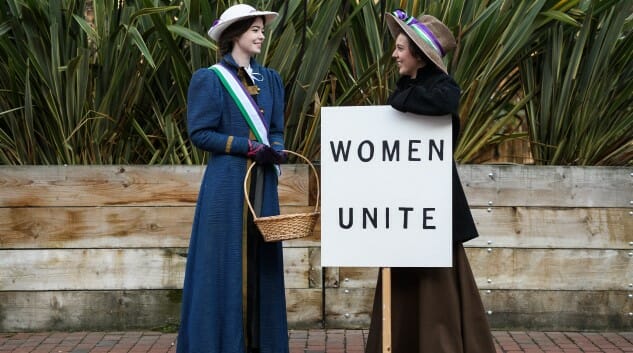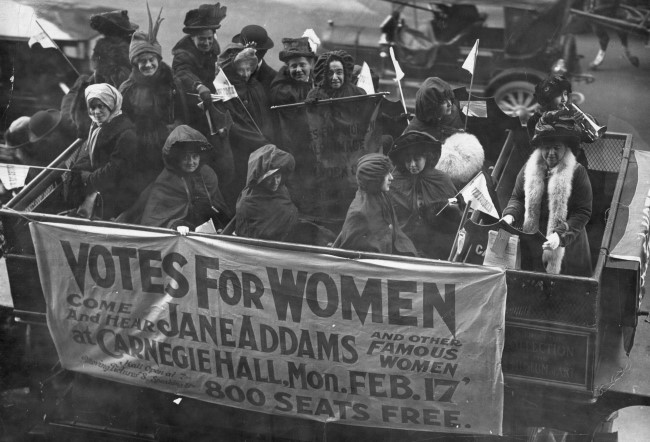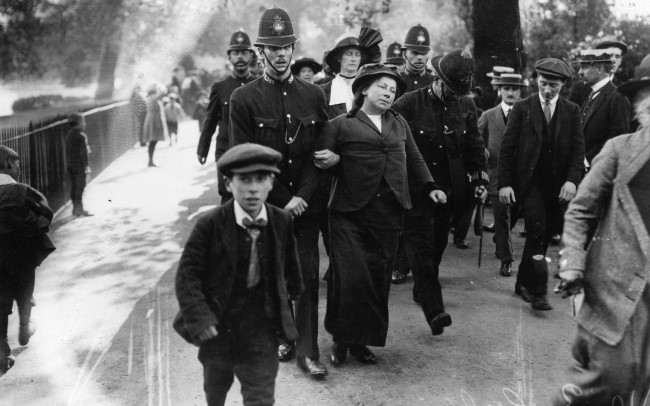How Big Beer Fought Against Women’s Suffrage, And We Got Prohibition as a Result
Photos via Getty Images, Henry Guttmann, Hulton Archive, Leon Neal, Central Press, Paul Thompson Drink Features alcohol history
This piece is part of a series of essays on alcohol history. You can read more here.
The history of alcohol, and the alcohol industry within the U.S., is endlessly fascinating. Take our recent essay on the extreme, almost unthinkable rate of American alcohol consumption during the early 1800s—the numbers are so high that it boggles the mind (and the liver), but to drinkers in 1830 it was just the way of the world, as they pounded pints of whiskey on the daily. Alcohol history is full of these wild stories.
Of course, not everyone chose to perceive that level of consumption as “normal,” or sustainable. It’s no coincidence that the era of America’s most flagrant and irresponsible alcohol abuse also resulted in the birth of its organized temperance movement, those early moral crusaders and idealists who formed temperance and abstinence societies nationwide. And they were surprisingly successful at it too, at least on a state level—in the 1850s, 13 different states and territories passed statewide Prohibition laws of varying effect, known as “Maine Laws” in honor of the first state to go dry in 1851. Few of these statewide Prohibition laws remained on the books for long, but they did contribute to an overall decline in alcohol consumption as the century drew to a close.
From there, rose the most powerful political pressure group the country had ever known, the Anti-Saloon League. Wielding an extraordinary amount of clout in rural portions of the country, the ASL and its charismatic leaders, such as the greatly feared Wayne Wheeler, were able to practically write the political platforms of candidates of the day by simply promising (or withholding) the support of ASL members at the polls. Their allies were numerous, eclectic and seemingly impossibly distant from each other in terms of political agendas and ideology—progressives, racists, xenophobes and women’s suffragists all bound together in the most unlikely of alliances, a desire to see alcohol made illegal for extremely different reasons. The bizarre nature of this alliance deserves an essay all its own, so for now let’s focus on one area in particular: How women’s suffrage got tied up in the quest for Prohibition, and how Big Beer fought tooth and nail to keep the vote out of the hands of women.
The Marriage of Suffrage and Temperance
To varying degrees, the suffrage movement and the temperance movement were always fairly closely linked. The nation’s first powerful temperance lobbying group was the Women’s Christian Temperance Union (the WTCU), which had a fairly wide slate of goals, including personal temperance (not necessarily Prohibition), missionary work and women’s suffrage. But it was the male-operated Anti-Saloon League that eventually came to dominate the greatest degree of power in this sphere, and one of the ways they did it was with a laser-precise focus on only a single issue: a national Prohibition amendment. Suffrage was forced to take a back seat as a result.
Nevertheless, the Anti-Saloon League really could have used the help of women voters. Its first serious attempt at a Prohibition amendment, introduced by Alabama representative Richmond Hobson in 1914, received a majority of votes in its favor, but far from the two-thirds majority needed to pass it into law. To reformers of the day, it must have felt like a bottleneck had been reached.
Thus arose the popular belief (on both sides of the alcohol argument) that if women were to receive the vote, the quest for Prohibition would be quickly achieved, putting the “dry” contingent over the top in terms of the votes they’d need to achieve a national amendment. This belief hinged not only on the existence of organizations such as the WCTU (and famous “bar-room smashers” like Carrie Nation ), but the overgeneralized notion that women were not drinkers, and were instead “innocent” creatures that would protect their men by stripping them of the temptation of alcohol.
 Suffragists campaign for the vote.
Suffragists campaign for the vote.
Famed author, American icon and lifelong alcoholic Jack London believed as much, and in his 1913 book John Barleycorn: Alcoholic Memoirs he specifically writes about an occasion in which he voted for a California women’s suffrage proposition in 1911—not as a matter of ethics, but because he was hoping that the enfranchised women would vote for Prohibition, and help sober him up as a result. As he wrote:
The women are the true conservators of the race. The men are the wastrels, the adventure-lovers and gamblers, and in the end it is by their women that they are saved. About man’s first experiment in chemistry was the making of alcohol, and down all the generations to this day man has continued to manufacture and drink it. And there has never been a day when the women have not resented man’s use of alcohol, though they have never had the power to give weight to their resentment. The moment women get the vote in any community, the first thing they proceed to do is to close the saloons. In a thousand generations to come, men of themselves will not close the saloons. You would as well expect the morphine victims to legislate the sale of morphine out of existence.
The somewhat naive London even thought that once a Prohibition amendment was passed, it would be a simple thing for lifelong alcoholics to quit, reasoning that if alcohol was difficult to acquire, he wouldn’t be tempted to acquire it:
And it will be easy. The only ones that will be hurt will be the topers and seasoned drinkers of a single generation. I am one of these, and I make solemn assurance, based upon long traffic with John Barleycorn, that it won’t hurt me very much to stop drinking when no one else drinks and when no drink is obtainable.
Nice thoughts, but not very realistic—more accurately, London’s words were the hopeful words of an addict who was begging for someone (the nation’s women) to help him go cold turkey. But his outlook does illustrate how closely the thought of women’s suffrage and national Prohibition were tied to one another in the American mindset, both on the side of the reformers and the drinkers. As author Daniel Okrent observes in his book Last Call: The Rise and Fall of Prohibition, “What had changed by the time London cast his wishfully opportunistic suffrage vote was the nature of the connection between the drys and the suffragists: Comfortable affinity had been transformed into absolute interdependence.”
Big Beer vs. Women’s Suffrage
No one was more aware of the threat presented by potential women voters than the kingpins of the pre-Prohibition American brewing industry. Because the spectre of women’s suffrage was so completely linked in the public mind to the looming possibility of Prohibition, the entire brewing industry aligned themselves vehemently against it, ending up on the wrong side of history in the process. As Okrent writes, in Last Call:
The brewers certainly knew the connection. [Susan B. Anthony]’s thoughts, even her language, echoed a resolution the United States Brewers Association (the USBA) had adopted several years earlier. The resolution declared, “When woman has the ballot, she will vote solid for Prohibition.” Consequently, the USBA made it official policy to oppose woman suffrage “everywhere and always,” a matter of conviction so deeply rooted it could only have been motivated by financial self-interest. It was no different for the distillers. In 1912, at a convention of the National Retail Liquor Dealers Association, the industry’s position was made clear when the organization’s president issued this call to arms: “Gentlemen, we need fear the Women’s Christian Temperance Union and the ballot in the hands of women; therefore, gentlemen, fight woman suffrage!”
 A female suffragist activist is arrested for marching in favor of women’s suffrage.
A female suffragist activist is arrested for marching in favor of women’s suffrage.
That the brewing industry would want to protect its business prospects from meddling women voters isn’t particularly surprising, but the lengths that the USBA (and particular brewing industry figures, such as Adolphus Busch) went to in order to fight suffrage were pretty galling. Take the case of Phoebe Couzins, one of the first female attorneys in the U.S. and a prominent suffragist for decades, leading into the late 1800s. In the late 1890s, however, the USBA literally paid a financially burdened Couzins to switch sides in the debate, going onto the Brewers Association payroll and renouncing the cause of suffrage. She then went on “independent” speaking tours for a number of years in which she spoke out against her gender receiving the vote. As Okrent notes:
(Couzins explained her shocking switch with bland opacity: “Observations made during my struggle to get the privilege of the ballot for my sex convinced me I was wrong.”) Adolphus Busch, who had personally promised Couzins a lifetime annuity on top of her monthly stipend from the USBA, told a colleague, “if ever should it become known that she is in the pay of the brewers … all of her work would be in vain.”
How sad and disturbing is that—to work toward a social equality goal for decades, only to go full Judas Iscariot, while Busch and co. line your pockets with silver. Couzins, if you were curious, eventually fell out of favor with the brewers a decade later. She returned to her hometown of St. Louis, where she lived in poverty and passed away in 1913—a sad end for a woman who was once one of the country’s most prominent suffragists.
But the brewers also had other weapons with which they attempted to mold public perception of women’s suffrage. The most shocking, perhaps, was a misinformation campaign that began in Texas and was eventually expanded nationwide, in which the USBA contributed politically charged, anti-suffrage editorials to small-town newspapers, while covering up the source of the spin. Per Last Call:
Distributing scores of free articles to hundreds of rural newspapers through a false front called the Farmers’ Educational and Cooperative Union, the brewers’ publicists-in-disguise promised country editors that the articles would provide a “discussion of both sides of important questions confronting the farmers of this nation.” What they actually supplied, without rebuttal, was the bogus testimony of bogus farmers, who offered such sentiments as “god pity our country when the handshake of the politician is more gratifying to woman’s heart than the patter of children’s feet.” Another favored form was the rhetorical puzzler that required no answer: “is it not sufficient political achievement for woman that future rulers nurse at her breast, laugh in her arms and kneel at her feet?”
These efforts can only be described as a craven way of fighting the suffrage movement, although they’re frighteningly similar to the same tactics that are still employed against women today—projecting guilt upon an entire gender for any kind of political or economic ambition beyond the biological responsibility of producing “the patter of children’s feet.” The suggestion that women should have simply been happy raising future male politicians, rather than choosing their representatives directly (or even BEING a representative), was a particularly vicious bit of misogyny.
 The suffragists also had heir own newspapers, of course.
The suffragists also had heir own newspapers, of course.
The irony, of course, is that the efforts of the brewing industry had basically the opposite effect that was intended. Unprovoked, the average woman voter in the 1910s might have voted against Prohibition just as likely as they would have voted in favor of it, but the misogynistic attitudes of the brewers to fight women’s suffrage made them obvious enemies of women in general, and made female support for Prohibition movements that much stronger. Through their fear that women would support the quest for Prohibition, and their desire to bar women from obtaining equal rights, the brewers sowed many of the seeds of their own destruction. As Okrent concludes:
“The fanatical and misinformed women,” as Adolphus Busch called them, would rout the brewers and their allies with stunning efficiency. In one three-year stretch in the 1910s, seven western states adopted Prohibition—all of them states where women had achieved the vote.
And ultimately, it was this momentum on the state level that made national Prohibition eventually seem like a looming inevitability; one that finally arrived in the form of the 18th Amendment, ratified in 1919 and put into effect in 1920. The 19th Amendment followed hot on its heels, giving women the right to vote in 1920—the combined payoff of two campaigns that had become symbolically linked. Left gnashing their teeth were the brewers, on the wrong side of an important moment in the history of civil rights in the U.S.A.
Today, the craft beer industry is an increasingly inclusive space for women, although continued vigilance is needed to keep things moving in the right direction, without reverting to a boys club mentality. Still, you have to figure some progress is probably being made, in the sense that even the modern Belgian-Brazilian ownership of Anheuser-Busch would know better than to refer to half the population as “the fanatical and misinformed women.” Baby steps, right?
Jim Vorel is a Paste staff writer and resident craft beer guru. You can follow him on Twitter for more drink writing.